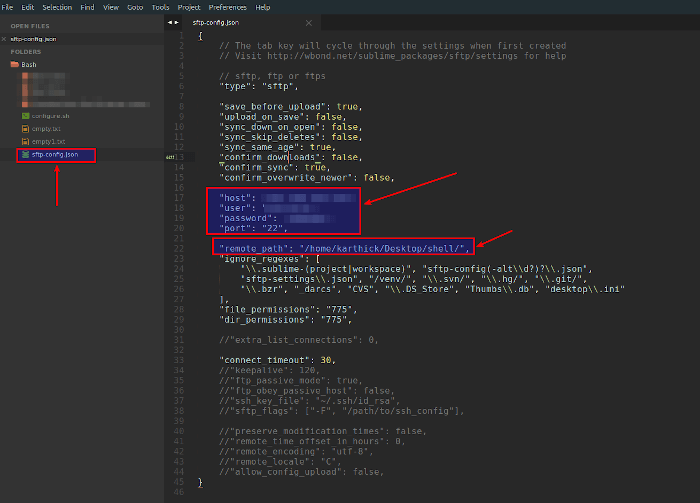
- #EDIT SSH FILE VIA SUBLIME TEXT WINDOWS HOW TO#
- #EDIT SSH FILE VIA SUBLIME TEXT WINDOWS CODE#
- #EDIT SSH FILE VIA SUBLIME TEXT WINDOWS WINDOWS#
Set up Sublime Text for light-weight all-in-one data science IDE was originally published by Kirill Pomogajko at Opiate for the masses on December 23, 2015. You might need to do a little trick in some cases so I also added config for Python and Hive to my Github page as an example. The above example is only to add remote R but basically the same procedure to add Python, Scala, Spark, Hive, Impala and technically anything on remote. Now you should see new remote_R REPL functionality was added to your SublimeREPL if you type remote_R in Command Palette (default key binding is command + shift + p)
#EDIT SSH FILE VIA SUBLIME TEXT WINDOWS WINDOWS#
By default, Windows only supports file paths less than 260 characters. "file": "config/remote_R/Main.sublime-menu" #CHANGE You may open a repo in your preferred external editor program using the Command. "command": "run_existing_window_command", "args": use the same view when opening the same file. Comparing to rsub, the followings are enhanced: support multiple files via rmate foo bar. It transfers files to be edited from remote server using SSH port forward and transfers the files back when they are saved. "caption": "SublimeREPL: remote_R", #CHANGE RemoteSubl starts as a fork of rsub to bring rmate feature of TextMate to Sublime Text. "syntax": "Packages/R/R Console.tmLanguage" If you copy & paste the below code, don’t forget to delete #CHANGE blah blah comment.

You’ll see caption and id are no longer “R” but “remote_R”. Open the files and edit some lines as shown below.įind the lines with #CHANGE, those are the ones I changed. Now we are going to give SublimeREPL access to your remote R (I assume you can SSH to your remote). cd YOURSUBLIMEREPLCONFIGFOLDER #Move to YOURSUBLIMEREPLCONFIGFOLDERĬp -r R remote_R #This will create remote_R folder This should be useful when you have local R script and like to evaluate it remotelly. Most probably you can find it by Sublime Text tab, Preferences, Brouse Packages, SublimeREPL, then config (I use OS X 10.10.5).Īs an example, we are going to add remote_R sublime interepreter config. Add custom SublimeREPL configįirst thing you need to do is to find out SublimeREPL config file location. When you have them installed, the only thing you need to do is to add a new SublimeREPL config. The above gif setup is heavily based on the following two packages By adding custom REPL, Sublime Text becomes an all-in-one tool for every data science task from hadoop ETL, Spark machine learning, HTML/CSS editing to markdown reporting. Sublime Text is a popular text editor with massive amount of plugins that provides quite a lot of what you need.

I especially wanted REPL functionality that takes single inputs, evaluates them, and returns the result for quick prototyping. But these are specialized in one language and what I wanted to have is a tool for broad and multi-language data science tasks with autocompletion, FTP, highlighter, formatter, split editing, local/remote evaluation and REPL. RStudio for R, Pycharm for Python, IntelliJ for Scala.
#EDIT SSH FILE VIA SUBLIME TEXT WINDOWS CODE#
The example below interprets local Python (top), R (middle) and Hive (bottom) code on remote.
#EDIT SSH FILE VIA SUBLIME TEXT WINDOWS HOW TO#
Here I introduce how to add custom REPL config for remote/local R, Python, Scala, Spark, Hive, you name it (this is only tested for OS X).


 0 kommentar(er)
0 kommentar(er)
